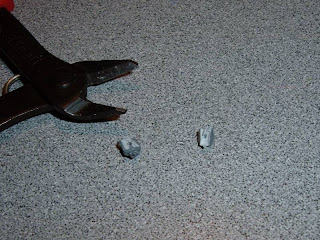For a reference, here's an unconverted Black Reach Warboss that I built a couple of months ago:
No, no, no. This is all wrong. For starters, my Freebootas don't use shotguns or the standard Slugga, and the bosspole is all wrong. To start fixing this, I grabbed the Warboss backpack & some Razig weapons from Reaper:
I started by chopping the shotguns and the bosspole off of the backpack:
...then I grabbed some flintlock pistols and chopped them down, and drilled out the spots for the pistols & bosspole on the backpack:
...then I cut the bits from the original bosspole and rearranged them:
Then I glued the flintlock pistols into the backpack. I also replaced the original pole with the harpoon from the Razig weapon pack, and added the original bosspole details to it:
The Slugga wasn't the right look - I decided my Warboss needed a musket. I started by removing the Slugga from his hand:
...then I shaved all the pieces from his hand (this was a major pain - if I had any other Ork arms that were a similar scale, I would've started with an empty hand instead). Then I drilled out his fist, cut the musket in half, filled the hole with Green Stuff and glued the musket in his hand:
Next, I decided that a "Power Klaw" wasn't right for my Freeboota Warboss - my Warboss would have a Power HOOK. (Remember, Ork technology just works, okay?) I started by chopping off most of the original Power Klaw:
Then I took some plasticard and started building up the arm:
I punched out some circles with my tiny hole punch, and used them to make some nice Orky rivets:
For the hook itself, I used some Chaos Marauder bits I got from eBay:
...mainly what I'm concerned with are the"hooks" at the end of this banner - I removed them with my hobby knife:
I decided that my "Power Hook" was going to need more wiring than the standard, so I drilled some holes to allow for this:
Next I glued the hook to the arm:
I needed something in the appropriate scale to represent the hydraulic hose I wanted to add to the Power Hook - I went and grabbed an extra set of guitar strings I had on hand:
I cut a small piece and wrapped it around the barrel of a pen to give it the proper "bend" without kinking it:
...then I glued the ends into the holes I had drilled:
Originally I thought about having two hooks on the arm, but I didn't like the way it looked when I mocked it up. This resulted in what I thought was too much "empty space" at the top of the arm, so I decided to fill it with another one of the Chaos Marauder bits:
...after several weeks of impatiently waiting, I received my Pirate Ork Heads from MaxMini:
I decided to go with this head for my Warbosses:
(I'm going to use the heads with the bicorne hats for my HQ, and the one with the metal jaw fits better with the look of the Black Reach Warboss model). Here he is after a quick coat of primer through my airbrush:
...In addition to the above, I didn't take pics of a lot of little details - a lot of the extraneous spikey bits were shaved from the torso & boots, and the legs/boots were re-sculpted like I did in this post). Overall I'm really pleased with how he came out - I hope the rest of them come out this well...













































































